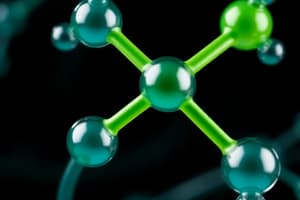Podcast
Questions and Answers
What is the molecular formula of peroxyacetyl nitrate given its percent composition by mass: 19.8% C, 2.5% H, 11.6% N, and an approximate molar mass of 120 g?
What is the molecular formula of peroxyacetyl nitrate given its percent composition by mass: 19.8% C, 2.5% H, 11.6% N, and an approximate molar mass of 120 g?
- C5H6N2O5
- C2H3N2O2
- C4H5N2O4 (correct)
- C3H4N2O3
What is the moles of sodium chlorate (NaClO3) in 284 grams of a 12.0% sodium chlorate solution?
What is the moles of sodium chlorate (NaClO3) in 284 grams of a 12.0% sodium chlorate solution?
- 0.50 moles
- 1.18 moles (correct)
- 1.75 moles
- 0.90 moles
How many grams of gold (Au) are present in 16.7 moles of Au, considering its atomic mass is 197.0 g?
How many grams of gold (Au) are present in 16.7 moles of Au, considering its atomic mass is 197.0 g?
- 3200 g
- 3283.9 g (correct)
- 2500 g
- 2000 g
If the atomic weight of magnesium is 24.3 g/mol, how many magnesium atoms are represented in 5 g?
If the atomic weight of magnesium is 24.3 g/mol, how many magnesium atoms are represented in 5 g?
What is the molecular weight of ferrous oxide (FeO)?
What is the molecular weight of ferrous oxide (FeO)?
Which principle states that electrons fill orbitals starting at the lowest energy states?
Which principle states that electrons fill orbitals starting at the lowest energy states?
What does the Heisenberg Uncertainty Principle describe?
What does the Heisenberg Uncertainty Principle describe?
What is the ppm of a substance if there are 50 mg dissolved in 10 L of solution?
What is the ppm of a substance if there are 50 mg dissolved in 10 L of solution?
Which rule indicates that each orbital in a subshell should have one electron before any can be paired?
Which rule indicates that each orbital in a subshell should have one electron before any can be paired?
Which of the following describes the term 'solute' in a solution?
Which of the following describes the term 'solute' in a solution?
What does the molar fraction of a solution represent?
What does the molar fraction of a solution represent?
In the context of partial volumes, what does Amagat’s Law state?
In the context of partial volumes, what does Amagat’s Law state?
Which of the following combinations of elements can be described as halogens?
Which of the following combinations of elements can be described as halogens?
What is the relationship between molarity and the number of moles of solute in a solution?
What is the relationship between molarity and the number of moles of solute in a solution?
How is molality defined?
How is molality defined?
What does normality measure in terms of a solution?
What does normality measure in terms of a solution?
What is the molarity of a solution if 13.0 grams of hydrogen peroxide is mixed in 300 mL of solution? (Molar mass of H2O2 = 34.02 g/mol)
What is the molarity of a solution if 13.0 grams of hydrogen peroxide is mixed in 300 mL of solution? (Molar mass of H2O2 = 34.02 g/mol)
What is the mole fraction of solute if the solution contains 75.5 grams of sucrose in 400 grams of water? (Molar mass of sucrose = 342 g/mol)
What is the mole fraction of solute if the solution contains 75.5 grams of sucrose in 400 grams of water? (Molar mass of sucrose = 342 g/mol)
What is the normality of a solution prepared from 0.5781 g of acid with an equivalent weight of 187.3 g/equiv in 250 mL?
What is the normality of a solution prepared from 0.5781 g of acid with an equivalent weight of 187.3 g/equiv in 250 mL?
Which statement about the concentration measures is incorrect?
Which statement about the concentration measures is incorrect?
In a mixture of 25.0 g of water and 25.0 g of ethanol, which calculation would help determine the mole fractions of each substance?
In a mixture of 25.0 g of water and 25.0 g of ethanol, which calculation would help determine the mole fractions of each substance?
Flashcards
Amagat's Law
Amagat's Law
The total volume of a gas mixture is the sum of the volumes of the individual gases in the mixture, at constant temperature and pressure.
Pauli's Exclusion Principle
Pauli's Exclusion Principle
No two electrons in an atom can have the same set of four quantum numbers.
Aufbau Principle
Aufbau Principle
Electrons fill the lowest energy levels (orbitals) in an atom first before filling higher levels.
Heisenberg Uncertainty Principle
Heisenberg Uncertainty Principle
Signup and view all the flashcards
Hund's Rule
Hund's Rule
Signup and view all the flashcards
Solute
Solute
Signup and view all the flashcards
Solvent
Solvent
Signup and view all the flashcards
Parts per Million (ppm)
Parts per Million (ppm)
Signup and view all the flashcards
Mole Fraction
Mole Fraction
Signup and view all the flashcards
Mole Fraction (solute)
Mole Fraction (solute)
Signup and view all the flashcards
Mole Fraction (solvent)
Mole Fraction (solvent)
Signup and view all the flashcards
Molarity
Molarity
Signup and view all the flashcards
Molality
Molality
Signup and view all the flashcards
Normality (N)
Normality (N)
Signup and view all the flashcards
Calculating Normality
Calculating Normality
Signup and view all the flashcards
Gram-Equivalent Weight
Gram-Equivalent Weight
Signup and view all the flashcards
Moles of Solute in Solution
Moles of Solute in Solution
Signup and view all the flashcards
Empirical Formula
Empirical Formula
Signup and view all the flashcards
Number of Atoms
Number of Atoms
Signup and view all the flashcards
Molecular Weight
Molecular Weight
Signup and view all the flashcards
Moles of Element
Moles of Element
Signup and view all the flashcards
Study Notes
Chemistry Overview
- Chemistry is the study of matter's composition, structure, changes during reactions, and properties.
- It originates from "alchemy," which comes from "al-kamia" meaning "cast together."
- Matter is anything that occupies space and has mass.
States of Matter
- Solid
- Liquid
- Gas
- Plasma
- Bose-Einstein Condensate
Phases of Matter
- Phase changes involve energy absorption or release (e.g., heat).
- Melting (solid to liquid)
- Freezing (liquid to solid)
- Sublimation (solid to gas)
- Deposition (gas to solid)
- Evaporation (liquid to gas)
- Condensation (gas to liquid)
- Ionization (gas to plasma)
- Deionization (plasma to gas)
Properties of Matter
- Physical Properties: Observed without changing substance (e.g., color, density, melting point).
- Chemical Properties: Observed only when substance changes to a new substance (e.g., flammability, reactivity).
- Intensive Properties: Independent of substance amount (e.g., boiling point, density).
- Extensive Properties: Dependent on substance amount (e.g., mass, volume).
Pure Substances
- Elements: Simplest substances, cannot be broken down chemically. (E.g., metal, metalloid, nonmetal).
- Compounds: Two or more elements combined chemically (e.g., water, salt).
Mixtures
- Mixtures are two or more substances mixed together, but not chemically combined.
- Homogeneous: Uniform appearance, single phase (e.g., solutions).
- Heterogeneous: Different distinguishable phases (e.g., suspensions, colloids).
Separation Techniques
- Decantation/Floatation
- Filtration
- Distillation
- Mechanical Separation
- Centrifugation
- Chromatography
- Solvent Extraction
- Amalgamation
- Cyanidation
Atomic Structure
- Atoms are the fundamental building blocks of matter.
- Atoms consist of a nucleus (protons and neutrons) and orbiting electrons.
Isotopes
- Isotopes of an element have the same number of protons but different numbers of neutrons.
Ions
- Ions are charged particles formed by adding or removing electrons from neutral atoms.
- Cations: positively charged ions
- Anions: negatively charged ions
Periodic Table
- Elements are arranged in the periodic table based on increasing atomic number.
- Elements with similar properties appear at periodic intervals.
- Groups (columns) and periods (rows) are used to organize elements.
Atomic Mass, Atomic Number
- Atomic number is the number of protons in the atom.
- Atomic mass is the total mass of protons, neutrons, and electrons in the atom.
Avogadro's Number
- Avogadro's number (6.022 x 10^23) represents the number of atoms or molecules in one mole of a substance.
Laws of Chemistry
- Conservation of Mass: Mass cannot be created or destroyed.
- Law of Definite Proportions: A chemical compound always contains the same proportion of elements by mass.
- Law of Multiple Proportions: When two elements combine to form more than one compound, the ratio of weights of one element combined with a fixed weight of the other is a simple ratio of small whole numbers.
Concentration
- Concentration is the measure of how much of one substance is present in another. -Parts per Million (ppm): useful to describe very dilute concentrations -Molarity (M): The number of moles of solute per liter of solution -Molality (m): The number of moles of solute per kilogram of solvent. -Mole Fraction(x): The ratio of moles of one component to the total number of moles of all components in a solution. -Normality (N): concentration expressed as the equivalence of solution.
Studying That Suits You
Use AI to generate personalized quizzes and flashcards to suit your learning preferences.




